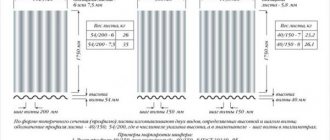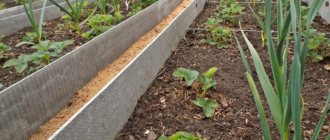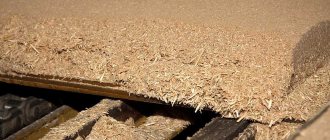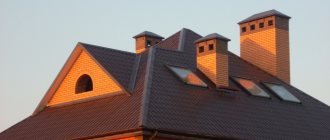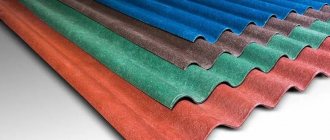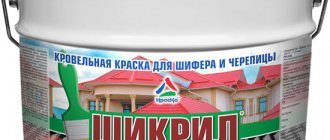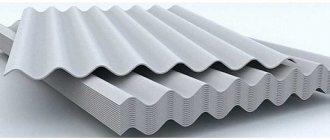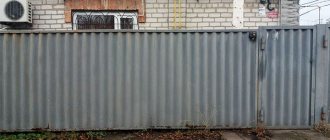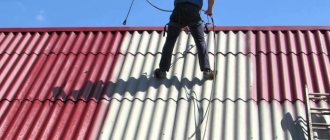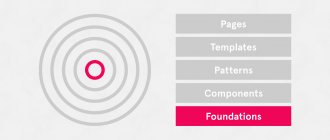The parameters of the roof and its quality are determined by the properties of the components: the rafter or truss system, the base, thermal and waterproofing and roofing material.
And in order for a structure to function properly, all its components must have not absolute, but corresponding characteristics.
This even applies to such a utilitarian parameter as mass.
Assortment of slate and its weight
This roofing material is made from a mixture consisting of Portland cement, asbestos and purified water. Slate is used not only for laying on the roof, but also for cladding walls.
During the manufacturing process, all components are mixed in appropriate proportions, then poured into molds and left until final hardening. The finished material is resistant to moisture and ultraviolet radiation, does not ignite and is not dangerous due to temperature changes.
There are two types of slate:
A little about slate
Both wave and flat slates are produced using the same technology, which is based on a molding composition consisting of:
- Portland cement grade M300-500, which acts as a binding element. It is present in the solution from 80 to 90% of the total mass.
- Chrysolite-asbestos in the form of a reinforcing frame, the volume of which in the solution is 10-20%.
- Water.
Traditionally, slate is a gray material. Today, many manufacturers, adding dyes to the molding mixture, offer material of different colors. The slate itself is attached to the frame system using special nails with a wide head. The sheets are mounted on the roof overlapping each other, usually offset by one wave.
Not everyone knows that today manufacturers offer roofing elements made from asbestos-cement composition. These are skates and connecting parts. Therefore, most often on roofs you can see these elements made of steel sheet. And this worsens the appearance of the roof structure.
Slate of different colors Source olestnicah.ru
How much does a slate sheet weigh?
Depending on the type of material and size, the weight of a slate sheet ranges from 23 to 39 kilograms. This means that per square area of the roof structure there is a load of 9-17 kilograms - this does not take into account the insulation.
To install a slate roof, you need to determine the weight of the roofing pie when calculating the foundation and rafter system for the house. Without the required safety margin, the roof structure will warp and eventually collapse.
How much does flat slate weigh 10 mm, 8 mm ↑
Flat slate is also widely used in various fields. The weight of the sheet in this case is determined not only by its dimensions, but also by whether it is pressed or unpressed. If an unpressed flat ACL weighs 18–104 kg, then a pressed one weighs 20–162 kg.
This material is often used as roofing. They cover both small buildings and fairly large objects, mainly in the economic sector. This is mainly due to the weight of the product, which is calculated at an average of 12 kg per 1 m2 (the minimum value is 10 and the maximum is 14 kg). Parameters are selected depending on the project and construction needs.
Features of installing slate on the roof
Knowing how much a sheet of slate weighs allows you to decide on the design of the roof rafter system on which this material will be mounted. Significant weight is the main feature of roofing work with coatings made from asbestos cement.
To eliminate problems with the operation of a slate roof, professionals advise:
When purchasing, you should carefully evaluate the external condition of the slate so that the coating is used no less than the period stated by the manufacturers.
Source
Slate weight - how much does one sheet and 1 m2 weigh?
Experts note that the functionality of the roofing will depend on factors such as the characteristics of the base, the structure of the truss structure, the presence of heat and vapor barriers, and the type of roofing material. All parts described must comply with technical specifications. When designing a rafter system, the covering of which is made of asbestos-cement sheets, one should take into account such an important parameter as the weight of the slate. It is the mass of this wave roofing product that our article will be devoted to.
Slate weight: an important parameter for roofing
Words such as “slate” or asbestos cement sheets are familiar to many firsthand.
Today, although this is an old-generation roofing material, it still does not lose its leading position in the construction market. It is easy to use, inexpensive and durable. How many people have ever wondered how much 1 m2 of slate weighs? Of course, this is not so important for people far from construction; it’s a different matter for professionals or amateur developers who intend to cover the roof with these materials. The weight of the slate is of particular importance for them, since, for example, the calculation of the rafter system depends on it.
How much it weighs is also important because its installation is done manually, that is, it requires physical effort, and considerable effort. The weight of the sheet must also be known when organizing the transportation of building materials in order to select transport with the appropriate carrying capacity.
Why do you need to know the weight of a slate roof?
The coating is considered one of the main ones in creating roofs for household buildings, so its choice must be approached with special responsibility. With the same overall dimensions, the weight of 1 sheet of the material in question will be different. This is especially important when designing a truss structure. But there is one important rule here: the thicker the asbestos-cement products, the stronger they are. Consequently, with increasing thickness, the weight of 7 wave slate also increases.
When choosing such materials, you can make a roof with a particularly durable coating, but such an option will place a significant load on the frame. In this regard, when designing truss structures, it is necessary to take into account the following indicators:
1. How much does a slate sheet weigh?
2. Maximum loads from the effects of wind and snow lying on the surface.
3. Loads during roof operation. Here the weight of building structures and the people who carry out installation work is taken into account.
When using the thickened wavy version, a thick wooden beam, as well as thick boards, are used to make the rafter structure, and the sheathing pitch is reduced. In this case, the cost of installing the roof increases, and its weight also increases. In this regard, at the design stage it is necessary to calculate the foundation so that it can withstand all the loads. One of the main values that are taken into account is the mass of 8-wave slate or other materials for installing the coating.
At the roof design stage, you need to decide on the method of laying asbestos-cement products. The amount of horizontal and vertical overlaps of the sheets will depend on the slope of the roof, wind and snow load. Sloping roof structures are subject to increased strength requirements. Sheets must be laid with increased overlaps over reinforced sheathing. During the calculations, the weight of 1 m2 of slate is determined, and then the weight of the entire coating.
As for the financial costs of installing a roof, asbestos-cement products are considered one of the cheapest. When building a reinforced roof, the cost of the rafter structure will exceed the cost of the coating. In some cases, it is necessary to know the weight of flat slate, especially if such material is used for lining the ceiling in garages, sheds or other auxiliary structures.
switching module for underfloor heating actuators
Slate weight 1m2 when disassembled
If not so long ago slate was considered the traditional and most popular roofing material, today it is a rather rare roofing option for new buildings. Asbestos-cement slate is found infrequently and is mainly found in utility rooms, garages and other outbuildings. At new facilities it was replaced by modern, more reliable, beautiful and durable roofing materials. But old buildings are still in most cases covered with asbestos-cement slate. Such buildings have been in use for many years, and therefore there is a need to completely replace the roof.
Slate weight 1m2 when disassembled
What are they made from?
The material in question is made from raw materials such as Portland cement, non-flammable substance asbestos and water. The proportion of these components is 4 to 84 to 11. In the overall composition of the mixture, asbestos-cement fibers perform the function of reinforcement. This feature makes the sheets resistant to tensile forces and other mechanical loads. At the moment, not every manufacturer adheres to the requirements of state standards, so the strength indicators of a particular product will depend not only on the thickness, but also on the size of asbestos fibers and the fraction of cement particles.
Composition and environmental friendliness of slate
The composition of slate is very simple, so it is easy to analyze. Components. included in the composition are: water, cement, asbestos fiber. Water and cement are certainly safe from an environmental point of view.
The same cannot be said about asbestos. It is he who makes many doubt safety. There are two types of asbestos: chrysotile asbestos and amphibola asbestos. Of these, the second option is considered harmful to health. Slate has been made from this material for some time by foreign manufacturers. After extensive testing, scientists came to the conclusion that this component is harmful and banned it. Amphibolasbestos is not used in the production of domestic raw materials, which means it is absolutely safe for use.
Each component in the composition performs its own function. Portland cement, due to its astringent properties, is a connecting link. Chrysotile asbestos serves as a reinforcing filler. It helps to keep the cement mortar in the required wavy shape and ensures a strong and reliable structure.
In addition, chrysotile, which is used in the production of domestic products, is used in combination with gypsum, resins, rubber, oils, and bitumen. This type is allowed in construction and industry in many countries.
Flat slate
Asbestos-cement products are supplied to the construction market in the form of flat and wavy, and the latter can have from 5 to 8 ridges. The thickness of materials with a flat surface can range from 5 to 40 millimeters, but the most common options are sheets with a thickness of 6 and 8 mm, as well as 10 mm.
Each of the described options has its own scope of use:
1. Asbestos cement sheets, having a thickness of 6 millimeters, are intended for constructing a subfloor and installing interior partitions; they are also used for finishing the house from the facade. Experts recommend painting the surface of flat slate. A layer of paint will give the product a waterproofing effect.
2. Moisture-proof and fire-resistant asbestos-cement sheets of 8 mm thickness are used for exterior finishing of facades of brick buildings, frame houses and panel buildings. The main property of the described products is considered to be an increased service life.
3. Flat slate sheets 10 millimeters thick are used for finishing building facades, roofing country houses, and installing fences. In addition, such material can be used to construct interior partitions.
As you know, the weight of flat slate will depend on its overall dimensions. Let's take a closer look at this parameter:
Slate installation
Before starting work, you need to calculate the amount of material needed . To do this, the length and width of the slopes are multiplied, the resulting value is divided by the area of one sheet, the result is multiplied by 10%. This premium is due to the fact that the slate is laid with an overlap . The roof of asbestos-cement corrugated sheets is laid according to the following scheme:
- Painting asbestos-cement sheets increases their operational potential. The first layer of paint is applied before installing them on the roof, the second layer is applied after the installation of the roof is completed.
- The overlap between the sheets in the horizontal plane is equal to one or two waves. The second option requires more money, but it increases the reliability of the design.
- The slate is attached to the sheathing using special self-tapping screws or self-tapping screws , which are distinguished by a larger head than standard products and the presence of a rubber lining under it. This design of the elements is due to the requirements for waterproofing the fastening areas.
- Holes for fasteners are marked and drilled in advance before laying the slate on the roof to avoid damage to the material during its installation. The diameter of the holes must exceed the diameter of the fasteners by 3 mm. The installation locations of screws or self-tapping screws should alternate from the lower corner of one wave to the upper cavity of another wave. The sheet is fixed, as a rule, at three points: along the edges and along the center line.
- Since slate is a heavy and fragile material, safety precautions must be observed when installing it. It is most convenient to lift asbestos cement sheets onto the roof using a system of blocks and a nylon cable . If the work is carried out on a low building, then you can get by with the help of other people without constructing such structures. Wooden scaffolds with steps are mounted on top of the roof - this will allow you to move along the roof and carry out repair work.
- A more detailed installation diagram is presented in the video below.
How to cut corners correctly
Wavy slate
The materials under consideration can be divided into three types:
For roofing of country houses and farm buildings, 7 and 8 wave are mainly used. Such products have the same size; they are distinguished only by the distance between the tops of the ridges. In the 7th wave sheet, the crest has a height of 54 millimeters, the distance between adjacent waves is 200 millimeters. In wave 8, the height of the crest is 40 millimeters, the distance between the tops of the waves is 150 millimeters. Now let’s take a look at how much 7 wave slate weighs. The length of such a product is 1.75 meters, the width can be 0.98 or 1.13 meters, the thickness of the material is 5.2 or 5.8 millimeters. Let's look at specific examples:
How much does 8 wave slate weigh? The weight of the described products also depends on the overall dimensions:
The weight of a particular product must be taken into account, especially if transportation of materials to the roof is carried out manually. One person can handle products weighing between 18-20 kilograms, but if the weight exceeds 25 kilograms, an assistant must be involved in moving the product.
Source
Slate sheet weight: how much does 7 and 8 wave sheet weigh?
The functional characteristics of the roof depend on a number of factors, including the characteristics of the rafter system, the characteristics of the base, the technical properties of hydro- and thermal insulation, as well as the roofing material. All components of the roofing pie must match the characteristics of each other and the supporting roof frame.
The weight of the slate is one of the parameters that should be taken into account when designing a rafter system for a building with asbestos-cement sheet covering.
.
Why is it important to determine the weight of a slate roof?
If you decide to choose classic wave asbestos-cement slate as a roof covering, it is important to carefully select the material itself (slate sheets vary in size and weight), as well as to design the load-bearing roof frame.
The thicker the asbestos-cement material, the higher its strength!
By choosing asbestos-cement material of increased thickness, you can build a roof with high strength values.
However, such a roofing covering will place an increased load on the frame, that is, it will be necessary to design a rafter system of increased strength - it will have to withstand with a reserve
:
A reinforced rafter system requires the use of thicker timber and boards and the installation of sheathing with smaller pitches.
This not only increases the cost of constructing the roof, but also significantly increases its weight
.
In turn, the walls and foundation of the building must be strong enough to withstand the load from this structure.
Rafter system under a slate roof
Obviously, the weight of the roof covering should be calculated
Weight of unified seven- and eight-wave slate
A sheet with seven waves can be produced with the following parameters
:
The weight of a seven-wave slate sheet depends on its thickness and width; The profile type and length are the same (see table below).
| Slate grade according to GOST, sheet size | Sheet weight, kg |
| type 40/150, 1750×980x5.2 | 18,0 |
| type 40/150, 1750×980x5.8 | 21,8 |
| type 40/150, 1750×1130x5.2 | 18,7 |
| type 40/150 1750×1130x5.8 | 23,2 |
Table. Types of seven-wave slate and its weight
Eight-wave slate is produced in the form of sheets of the following format
:
The weight characteristics of eight-wave slate, taking into account the dimensions and type of profile, are in the table below.
| Slate grade according to GOST, sheet size | Sheet weight, kg |
| type 40/150, 1750×1130x5.2 | 20,6 |
| type 40/150, 1750×1130x5.8 | 26,1 |
| type 54/200, 1750×1130x6.0 | 26 |
| type 54/200, 1750×1130x7.5 | 35 |
Table. Types of eight-wave slate and its weight
The weight of one element of wave roofing is important to take into account when planning roofing work - each sheet must be lifted onto the roof, and if slate weighing 18 kg can be handled alone, then sheets weighing 26 kg or more must be lifted with an assistant.
To calculate the weight of the roofing, you need to calculate how much weight one square meter of slate has.
Production technology and quality standards
Wave slate is produced on the basis of GOST 30340-95. It applies to asbestos-cement corrugated sheets, as well as to its components used for roofing or fencing buildings and structures.
The technology for producing asbestos fiber was patented in the 19th century in England. The modern manufacturing process has not changed much since those times. In Russia, the production of this material was launched in 1908. Asbestos fibers are quite strong; in addition to them, Portland cement and soda are used. The resulting asbestos mesh structure provides a strong base for the slate sheet. An important point in production is the obligatory observance of the proportions of cement and asbestos fibers. Existing standards allow domestic manufacturers to produce many installations of various types for manufacturing.
The production process occurs in several stages:
- At the beginning, the pulp is mixed using a mixing bucket mixer.
- The resulting mixture is then recovered and transferred to a sheet forming apparatus. This process lasts about 30-90 seconds.
- The strips are then cut using specialized scissors.
- After this, the process of creating waves using drums occurs.
- The finished sheets are sent to the next stage for hardening.
- At this stage, water saturation of the prepared samples occurs.
- Sent to a high-temperature warehouse for drying.
- Upon completion of all these steps, the product becomes durable and ready for use.
All types of corrugated slate have their own parameters, which are also controlled by GOST. During production, a certain solution of plastic consistency is used, which consists of chrysotile asbestos, water and Portland cement. The interaction of all components allows us to produce high-quality, strong and durable material.
To obtain a high-quality look, you must adhere to strict standards:
- Maintain the correct ratio of asbestos fibers, cement and water, which is prescribed in GOST.
- Manufacturing should be carried out only on high-quality equipment that can evenly and accurately distribute asbestos in the raw materials.
- Adhere to regulatory documents regulating the production process.
How to calculate the weight of a slate roof covering
Using table values, you can obtain information about how much slate of a certain type and size weighs. But the actual weight of the material depends on the manufacturer - its composition may include chrysotile, the amount of asbestos and its mechanical properties may differ from those prescribed by GOST, etc.
If you want to calculate the weight of the roof covering of a future roof as accurately as possible, it is recommended to select in advance a reliable manufacturer of asbestos-cement material - when making calculations, it is convenient to focus on the weight of the corrugated sheets that it produces.
To calculate how much 1 m2 of slate weighs, you need to divide the mass of the sheet by its area. To calculate the area, the length of the decking element is multiplied by the width.
Let's look at the procedure using a specific example.
8 wave sheet with dimensions 1750x1130x5.2 mm type 40/150 weighs 20.6 kg.
We calculate the sheet area (in meters) using a calculator: 1.75 x 1.13 = 1.9775 (m)
Then divide the weight of the sheet in kilograms by the area of the sheet in meters:
20.6: 1.9775 = 10.417 (kg) weighs 1 m 2 of asbestos-cement sheet with the given parameters.
This calculation allows you to find out the weight of one square meter. meters of wave material based on the total area of the sheet, not the useful one!
This point must be taken into account when calculating the weight of the roof. When designing a roof, the amount of material required, including asbestos-cement sheets, is calculated. The elements are laid overlapping, so part of the sheet is “lost” - this is why the concept of the useful area of a flooring element appears.
But when calculating the weight of the roofing, overlaps cannot be neglected - their mass does not disappear anywhere
.
It is also necessary to take into account that when laying slate with cutting corners, part of the mass is lost - this leads to a slight decrease in the total weight of the roofing deck!
Trimming corners on a slate sheet
This means that calculating the weight of an asbestos-cement coating by simply multiplying the mass of 1 square meter. meter of material per slope area is impossible. It is necessary to determine the required number of corrugated sheets, find their total nominal area, and multiply the resulting value by the mass of a square meter of material.
Correct calculation of the technical characteristics and weight of the roofing covering at the design stage of the building will allow optimizing the costs of constructing the rafter system and arranging the roofing pie.
Source
Weight of sheet 7 wave, 8, 6 ↑
ACL can be transported to the construction site using small-sized transport. It is obvious that its load capacity is strictly limited, so it is understandable why it is so important to have an idea of how much 1 sheet of material weighs.
Considering the large assortment of ACLs, let’s determine the parameters of the main varieties, in particular, how much 7-wave, 8-wave and 6-wave slate weigh. This parameter provides an answer to such important questions for construction as whether the structure will be able to support the entire mass of the coating, or whether it will cause excessive shrinkage.
A certain confusion in the state of things is brought about by the fact that sheets manufactured by different manufacturers according to their own specifications may have some variation in the dimensions of thickness, length and width. Naturally, this must necessarily affect the final weight of the product.
Therefore, we will consider profiles made according to the requirements of state standard 30340-95. In suburban construction, 7-8-wave profiles of standard size 40 by 150 are mainly used. As indicated in GOST, their thickness can take two values - 5.8 and 5.2 mm. In the first case, the mass is:
- eight-wave product is equal to 26.1 kg;
- seven-wave – 23.2 kg.
A thickness reduction of just 0.6 mm lightens the profiles by approximately 4–4.5 kg.
Laying of the wave material is carried out with an overlap of one or two waves by the adjacent sheet, which reduces the usable area. It is its value that is used when calculating the number of profiles required to cover a given roof. When making calculations, you can use the following hint: to cover 100 m2, you need 64 eight-wave profiles or 75 seven-wave profiles.
Let's calculate the load exerted by a roof covering made of corrugated material per 1 m2. For an eight-wave profile, the number of sheets (64) is multiplied by the weight of each of them (26.1 kg), after which the result (1670 kg) is divided by 100. As a result, we obtain that the eight-wave profile affects 1 m 2 of roofing structure with a load of 16, 7 kg. For a seven-wave one, this value is 17.4 kg.
A larger load requires more floors, so for buildings with a light foundation, eight-wave material is used, since it acts on the walls and foundation with less force.
When developing a roof design, the load created by natural phenomena, such as snowfall, is additionally taken into account. The weight of products of standard size 50 by 200 (six-wave profile) is determined by its thickness: at 6 mm it is 26 kg, and at 7.5–35.
The mass of this roofing material, in addition to its size and thickness, also depends on factors such as the composition and structure of the profile, say, the degree of grinding of raw materials at the stage of molding the product. Many homeowners today prefer painted material - it is more practical and more weather-resistant, not to mention the expressiveness of the roof. So, priming and painting also leads to a certain increase in the weight of the profiles.
Increases the load from the asbestos-cement profile and increases humidity. This fact is also taken into account in GOST standards - calculations related to the mass of these products are performed taking into account a humidity of 12%.
Standard weight of one sheet of flat and wave slate
There are almost no restrictions for slate coverings, but materials made from asbestos, cement and sand have a significant mass. The weight of the slate influences the choice of cross-section of the rafter system elements; it is taken into account when calculating the foundation. The material is manufactured in accordance with GOST 30.340 - 1995, which regulates the thickness of the sheets, the number of waves on the surface, and the dimensions of the products. Manufacturers working according to technical specifications (TU) produce products that differ slightly from the standards.
Application in construction
Today, wave slate is widely used for the construction of industrial buildings and structures, as well as in the construction of residential premises. This popularity is due to its strength and wear resistance. It ranks first among roofing materials, while leaving its competitors behind. Its use guarantees the structure's reliability and durability.
Manufacturers produce products in various colors, this allows you to choose the right type of roof for any design. Also, painting allows you to increase the service life of slate significantly.
Before you start installing the roof, you need to find out how many sheets may be needed. First you need to measure the roof. Then you need to determine the length of the overhang. The choice of sheet size is influenced by the shape of the coating. The easiest way to produce roofing is with straight and non-curly shapes. This allows you to reduce work time. After all the preparatory work, you can proceed directly to the installation of the roof. Applying roofing material to the surface will help increase the thermal insulation function of the roof.
More and more new and advanced roofing materials are appearing on the market. There is even a risk that demand for it may decline. Therefore, experts are engaged in its improvement. The appearance of a double-sided protective coating on its base made it environmentally friendly.
Slate assortment
The product contains Portland cement and chrysolite asbestos fibers, the mixture is dissolved with water. Modifiers and plasticizers are added to improve the properties of the material.
They produce varieties of products :
Modern slate sheets are low cost and of good quality. Standard asbestos cement sheets are most often used. Flat ones are used for fencing, and wavy ones are used as roofing.
Unified slate
Material with the designation HC is classified as an economical type , since when cutting the material, a small amount of waste is obtained. The dimensions of the products are smaller than reinforced sheets, but larger than those of an ordinary profile. The thickness of the panels for the 40/150 marking is 5.8 mm, and for the 54/200 marking it is 6 – 7.5 mm. A slate sheet weighs 25 - 30 kilograms.
codes for geometry dash time room
Strip sizes:
A unified option is installed if you need to cover a large roof of a simple shape, flat without arches.
Regular profile
VO slate is used for small coverage areas
Marked with the letters VO. They are installed on the roofs of private buildings with a small square footage . On small roofs, panel sizes help avoid a lot of cutting and adjusting. In the kit, additional asbestos cement elements are purchased to cover junctions, ridges, valleys, and valleys. The thickness of the material is 5.8 - 6 mm for model 54/200, and for grades 40/150 - 5.2 mm.
Dimensions of slate products:
Slate is classified as a durable material, so when calculating the sheathing, they save money, because the bars are placed sparsely. Slats with a cross section of 5 x 5 cm are mounted in increments of 50 - 70 cm, which depends on the slope of the slopes. Bars with a cross section of 75 x 80 mm are used on the rafters; they are placed at intervals of 0.7 - 1.1 m.
Strengthened version
Dimensions of reinforced slate:
During production, such slate undergoes enhanced quality control; samples from each batch are checked for strength and compliance with geometric parameters.
Flat sheets
For marking, the letters LP-P are used, which means a flat pressed sheet; the letters LN-NP are also used (flat sheet, not pressed). The thickness and dimensions of products differ depending on the purpose of the material and the manufacturer of the product. Flat slate panels are not used for roofs ; they are used for fences, external and internal partitions.
Dimensions of flat slabs:
The most popular panels are 1.75 x 1.12 m; their thickness varies from 8 to 20 mm; the mass of the element largely depends on this indicator. For example, with a thickness of 10 mm, a sheet weighs 100 kg, and a product with a thickness of 8 mm over 60 kg. A slate slab with a thickness of 6 mm has a mass of 40 kg.
Features of slate roofing
Modern sheet slate is the most popular option for a financially affordable roofing material with optimal technical characteristics. Today, when carrying out roofing work, it is popular to purchase and use mainly corrugated sheets (flat slate is practically not in demand for this task). Among manufacturers, the wave slate produced is divided into the following varieties (a summary table has been compiled).
| Kinds | Marking | Standard sheet size, mm | Note |
| Wavy | IN | 1200×680 | Rectangular product (perfectly accurate geometric figure) |
| Reinforced corrugated slate type | VU | 2800×1000 | Reinforced structure recommended for use in industrial facilities |
| Unified | UV | 1750×1125 | The unified type of product is used privately |
Wavy-type asbestos-cement sheets are distinguished by the number of bends the product has. Depending on this, the forms of 6-wave, 7-wave and 8-wave slate building materials are distinguished. They produce building materials for roofs (and other purposes) in accordance with GOST 30340-2012. If an enterprise uses its own specifications when designing products, then the dimensions (and any other indicator) often differ from those regulated by state standards, but this is not considered a violation.
Attention! When purchasing, check what documentation is used in the production process of a particular supplier.
However, what positive qualities slate corrugated sheeting has does not depend on the technological features of the production process. Among the available advantages when covering buildings with sheet asbestos-cement building materials:
- low thermal conductivity;
- fire resistance and tolerance of critical temperatures;
- high frost resistance;
- the cost level is much lower than the prices at which metal tiles or soft roofing, for example, ondulin, are sold;
- ease of processing and installation when constructing any surface;
- extremely long operating period;
- optimal level of strength;
- sound and noise absorption;
- wide assortment selection, in particular, such criteria as profile type, different colors, dimensions, etc. are classified.
Follow a number of recommendations to eliminate possible shortcomings that appear when building materials are actively used.
- Handle products carefully during transportation.
- If the level of humidity in the environment is high, or the building material is exposed to direct influence of atmospheric water, clean the ridges, depressions and the rest of the slope from moss.
- Treat the building material by applying a layer of paint and varnish compounds to ensure moisture resistance and also give it greater aesthetics.
Having found out how slate building materials differ, and also having studied its properties, you can consider the technological details that help you perform calculations based on such a value as the mass of the roofing building material.
Technical characteristics of wave slate
Slate with corrugations on the surface has a long service life, on average 40 years or more . In difficult conditions, the coating does not collapse for 10 years. It is easy to install and dismantle slate; the work does not require a highly qualified roofer.
Sheet material is not destroyed by temperature changes, humidity, and does not corrode . During installation, the sheets can be walked on; they do not crack under the weight of a person. Slate does not burn during a fire and does not melt. The panels do not accumulate static electricity.
The weight of slate sheets individually is small, so they are delivered to the roof without a crane.
Dependence of weight on the number of waves on the surface
More often they use a profile with 7 or 8 corrugations on one sheet, since the material is ideal for residential roofs. For such sheets, the working area is almost no different from the total quadrature. This is explained by the fact that the covering is laid with an overlap in one wave, and for 7 and 8 wave slates the width of the corrugation is small.
For production, raw materials of different widths The initial overall width used in the production of slates with different numbers of corrugations affects the weight of the final slate model. Weight also depends on the wall thickness of the material. Previously, sheets with dimensions of 0.68 x 1.2 m were produced, weight was about 9 kg . Manufacturers are now making large-sized panels.
Six wave material
The sheets are produced in dimensions of 1.12 x 1.75 m, the thickness ranges from 6 to 7.5 mm, the distance between the corrugations is 200 mm.
Weight of 6-wave slate slab:
Six-wave slate is produced reinforced, so it is used for a flatter roof (with a slope of 10 - 12°). The coating will be able to withstand the load from snow crust.
Seven-wave slate
The size of the panels with seven waves is 1.75 m in length and 1.13 m in width. The working area is 1.336 m2. The wave pitch is prescribed in GOST standards, the corrugation height is 40 mm, the pitch is 150 mm, sheets with a thickness of 5.2 and 5.8 mm are produced.
Weight of 7-wave slate sheet:
Products with 7 waves on a plane are placed on the roofs of houses, bathhouses, gazebos, and outbuildings. The panels come in unified, reinforced and ordinary appearance.
Eight wave sheets
Sheets are produced with a thickness of 5.2; 5.8; 0.6; 0.75 mm. The weight of slate depends on moisture saturation , therefore all weight characteristics are given for conditionally dry material with a moisture content of no more than 18%.
Standard 8 wave slate weighs:
With single-wave overlap, the working quadrature is 1.57 m², and the total quadrature is 1.97 m².
Weight of flat slate sheets
Smooth sheets are produced pressed and unpressed. The difference lies in the method of gaining strength from the wet mass. In the first case, the blanks are treated with pressure under a press to compact them, then dried under natural conditions. The second method does not involve pressing; the raw materials dry without compaction.
Weight of smooth slate panels:
Pressed products are distinguished by greater density, hardness, and strength. They can withstand more freezing and thawing. But after exhausting the calculated and practical life, pressed sheets reduce their properties to 40% of the original ones. Unpressed ones are designed for fewer frosts, but after the deadline they still have up to 80–85% quality.
Source
Number of combs
Nevertheless, wave slate is more often used for the construction of roofs. Manufacturers produce products of different sizes, so that they are suitable for private construction, in which small-sized buildings predominate, and for the construction of industrial buildings of enormous area. In accordance with GOST, slate with a standard, unified and reinforced profile is distinguished for this type of product. But it is easier for the client to navigate using another classification based on the number of waves in the page:
- 5-wave. Slate with 5 ridges on the surface is an innovation in the construction market, the effective use of which has not yet been found. The page size of this material corresponds to the dimensions of 8-wave, but due to the larger wave width, the required coverage area is only 1.6 m2. It turns out that 20% of the surface of the material is “eaten up” by the overlap.
- 6-wave. This type of slate is produced with a page size of 1125x1750 cm, a thickness of 6-7.5 mm, and the distance between the ridges is 20 cm. It has a reinforced profile and weighs 26-35 kg, therefore it is used for construction in regions with high wind loads, for covering industrial structures of a huge area.
- 7-wave. This type of slate with 7 ridges is classic; therefore, it has standard dimensions of 850x1750 cm, a page thickness of 5.8 mm and a weight of 23 kg. Due to the small coverage area and lightweight weight, 7-wave asbestos-cement roofing is widely used in private low-rise housing construction.
- 8-wave. The dimensions of this type of slate are 1130x1750 cm, thickness 5.2 mm or 5.8 mm, required page area - 1977 cm. It is popular in industrial buildings due to its impressive dimensions. The weight of each page is 23-32 kg, depending on the thickness of the material.
Fundamentally important! Slate is considered a reliable and durable coating; it lasts for at least 20-30 years. This inexpensive roofing material can withstand temperatures in the range from -50 to +80 degrees and does not burn. The weakness of the cipher is targeted strikes, which can easily lead to splitting the page. This feature must be taken into account during transportation, storage, and installation of asbestos-cement coating.
